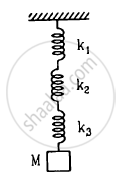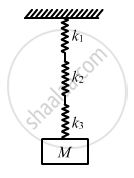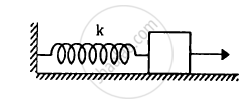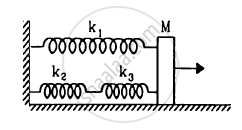Advertisements
Advertisements
Question
Find the elastic potential energy stored in each spring shown in figure when the block is in equilibrium. Also find the time period of vertical oscillation of the block.

Solution

All three spring attached to the mass M are in series.
k1, k2, k3 are the spring constants.
Let k be the resultant spring constant.
\[\frac{1}{k} = \frac{1}{k_1} + \frac{1}{k_2} + \frac{1}{k_3}\]
\[ \Rightarrow k = \frac{k_1 k_2 k_3}{k_1 k_2 + k_2 k_3 + k_3 k_1}\]
\[\text { Time period }\left( T \right)\text{ is given by, }\]
\[T = 2\pi\sqrt{\frac{M}{k}}\]
\[ = 2\sqrt{\frac{M\left( k_1 k_2 + k_2 k_3 + k_3 k_1 \right)}{k_1 k_2 k_3}}\]
\[ = 2\sqrt{M\left( \frac{1}{k_1} + \frac{1}{k_2} + \frac{1}{k_3} \right)}\]
As force is equal to the weight of the body,
F = weight = Mg
Let x1, x2, and x3 be the displacements of the springs having spring constants k1, k2 andk3 respectively.
For spring k1,
\[x_1 = \frac{Mg}{k_1}\]
\[\text { Similarly }, x_2 = \frac{Mg}{k_2}\]
\[\text { and } x_3 = \frac{Mg}{k_3}\]
\[ \therefore {PE}_1 = \frac{1}{2} k_1 x_1^2 \]
\[ = \frac{1}{2} k_1 \left( \frac{Mg}{k_1} \right)^2 \]
\[ = \frac{1}{2} k_1 \frac{M^2 g^2}{k_1^2}\]
\[ = \frac{1}{2}\frac{M^2 g^2}{k_1} = \frac{M^2 g^2}{2 k_1}\]
\[\text { Similarly }, {PE}_2 = \frac{M^2 g^2}{2 k_2}\]
\[\text { and } {PE}_3 = \frac{M^2 g^2}{2 k_3}\]
APPEARS IN
RELATED QUESTIONS
The maximum speed and acceleration of a particle executing simple harmonic motion are 10 cm/s and 50 cm/s2. Find the position(s) of the particle when the speed is 8 cm/s.
A particle having mass 10 g oscillates according to the equation x = (2.0 cm) sin [(100 s−1)t + π/6]. Find (a) the amplitude, the time period and the spring constant. (c) the position, the velocity and the acceleration at t = 0.
A block suspended from a vertical spring is in equilibrium. Show that the extension of the spring equals the length of an equivalent simple pendulum, i.e., a pendulum having frequency same as that of the block.
A block of mass 0.5 kg hanging from a vertical spring executes simple harmonic motion of amplitude 0.1 m and time period 0.314 s. Find the maximum force exerted by the spring on the block.
A body of mass 2 kg suspended through a vertical spring executes simple harmonic motion of period 4 s. If the oscillations are stopped and the body hangs in equilibrium find the potential energy stored in the spring.
The block of mass m1 shown in figure is fastened to the spring and the block of mass m2 is placed against it. (a) Find the compression of the spring in the equilibrium position. (b) The blocks are pushed a further distance (2/k) (m1 + m2)g sin θ against the spring and released. Find the position where the two blocks separate. (c) What is the common speed of blocks at the time of separation?

In following figure k = 100 N/m M = 1 kg and F = 10 N.
- Find the compression of the spring in the equilibrium position.
- A sharp blow by some external agent imparts a speed of 2 m/s to the block towards left. Find the sum of the potential energy of the spring and the kinetic energy of the block at this instant.
- Find the time period of the resulting simple harmonic motion.
- Find the amplitude.
- Write the potential energy of the spring when the block is at the left extreme.
- Write the potential energy of the spring when the block is at the right extreme.
The answer of b, e and f are different. Explain why this does not violate the principle of conservation of energy.

The spring shown in figure is unstretched when a man starts pulling on the cord. The mass of the block is M. If the man exerts a constant force F, find (a) the amplitude and the time period of the motion of the block, (b) the energy stored in the spring when the block passes through the equilibrium position and (c) the kinetic energy of the block at this position.

The springs shown in the figure are all unstretched in the beginning when a man starts pulling the block. The man exerts a constant force F on the block. Find the amplitude and the frequency of the motion of the block.

Find the elastic potential energy stored in each spring shown in figure, when the block is in equilibrium. Also find the time period of vertical oscillation of the block.
A rectangle plate of sides a and b is suspended from a ceiling by two parallel string of length L each in Figure . The separation between the string is d. The plate is displaced slightly in its plane keeping the strings tight. Show that it will execute simple harmonic motion. Find the time period.

When a particle executing S.H.M oscillates with a frequency v, then the kinetic energy of the particle?
When the displacement of a particle executing simple harmonic motion is half its amplitude, the ratio of its kinetic energy to potential energy is ______.
If a body is executing simple harmonic motion and its current displacements is `sqrt3/2` times the amplitude from its mean position, then the ratio between potential energy and kinetic energy is:
A body is executing simple harmonic motion with frequency ‘n’, the frequency of its potential energy is ______.
A body is executing simple harmonic motion with frequency ‘n’, the frequency of its potential energy is ______.
A body of mass m is attached to one end of a massless spring which is suspended vertically from a fixed point. The mass is held in hand so that the spring is neither stretched nor compressed. Suddenly the support of the hand is removed. The lowest position attained by the mass during oscillation is 4 cm below the point, where it was held in hand.
What is the amplitude of oscillation?
An object of mass 0.5 kg is executing a simple Harmonic motion. Its amplitude is 5 cm and the time period (T) is 0.2 s. What will be the potential energy of the object at an instant t = `T/4` s starting from the mean position? Assume that the initial phase of the oscillation is zero.
The total energy of a particle, executing simple harmonic motion is ______.
where x is the displacement from the mean position, hence total energy is independent of x.
